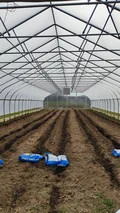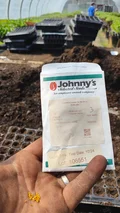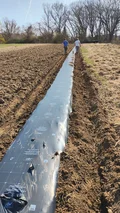TL;DR
We did a lot of shorter tasks while waiting for a shipment that included row cover and irrigation components.
There’s Always Something to Do
Even, maybe especially, while you’re ‘waiting for a shipment to arrive’, there’s always at least a dozen shorter tasks around a farm that can take up the time and prepare for whatever is coming next. For instance, today I:
- Mulched more leeks, like yesterday
- Collected salt marsh ‘hay’ (straw), like yesterday
- Filled greenhouse trenches with compost
- Migrated fertilizer bags to the greenhouse
- Cut and laid out drip irrigation lines in the greenhouse
- Watered and collected eggs from the chickens
- Baited the electric fences with peanut butter (trains the deer)
- Seeded radicchio and other lettuces (about a dozen)
- Helped load the shipment off the truck and on to the Gator trailer
- Brought various items from shipment to parts of the property
- Learned about using a “Gro-Trak” attachment to lay down biodegradeable mulch
More Progress on the New Greenhouse
The trenches had been dug since Tuesday and now it was time to fill them with compost and a sprinkle of fertilizer. Lugging dozens of buckets of soil was quite the exercise, but fortunately it was 60°F and even in the greenhouse it wasn’t too hot.
Then we cut and laid drip irrigation hose by having the spool at one end, holding the end and walking it down to the other end, then dropping it there and walking back to the spool end to cut and start again. This type of 1-inch tube came pre-perforated, just enough to emit water every 6 inches or so at the right flow rate. We needed 16 lines because each of the 8 trenches needed two lines on either side of a trench. At the far end, each line was tied with three knots in order to terminate the flow. Others on the crew then connected these lines to a 2-inch tube used as a header to equally distribute the water down the 1-inch lines.
Chicken Assistance
Then a few of us picked up 5-gallon containers of water, some hay, the egg buckets, and some feed to bring down to the chickens. The mobile chicken huts are currently at the very end of the field that the leeks are in, so we had plenty of hen chatter to listen to for the past week.
We collected about 20 dozen from ~300 birds in one day. This is why after about 3 days, we get around 60-65 dozen for washing. Then we ran the eggs up to the barn to store in the walk-in fridge.
Seeding Radicchio
Then we seeded a dozen or so trays up. The variety of Radicchio seeds were small (not tiny) and look like little fluted cones, bright yellow, and easy to see. Some seeds are tiny, round, and dark…making the seeding process for a fat-fingered guy like me rather difficult. There are ways to handle tiny seeds, such as putting them on a plastic cover with a small cut to allow only a few seeds to escape slowly at a time, but it’s best just to get used to ‘pinching’ them between your fingers, then carefully rolling two fingers to let one or two go at a time.
In a later blog post, I’ll share research on devices used to help seeding, but sufficed to say that this farm does many things manually on purpose, leaving only the most onerous tasks to tractor and automation. I respect that the farm GM Jamie has worked with the owners of the property in stages, each year further improving the approach to the labor and its outcomes for the local community. I have many years of observation to go and it’s nice to get some exercise anyway.
Deer Training and Fences
After lunch, I was put on the leisurely task of ‘baiting’ the electric fence that goes all the way around the main plots with peanut butter. For each section of the fence between poles, I smudged a small bit of peanut butter with my fingers onto the wire. This attracts deer who are not yet trained to lick the fence and get a minor shock. I have gotten shocked a handful of times myself and, while it’s not pleasant, it’s completely harmless. This effectively trains the deer to rightly think that the vegetables are off limits. For about 2 acres, this took about 30 minutes.
The Shipment Finally Came
Ever since the old row cover blew off a few of the rows over the weekend, we were waiting for a shipment with new row cover, not to mention an assortment of other necessary things. This included two new water pumps (for the greenhouse and replacement of the old one), a bunch of row cover, biodegradable black mulch sheets, drip irrigation, garden fabric staples, and a few other things. About a cubic pallet’s worth, we loaded off the A. Duie Pyle truck and on to the trailer hooked up to the Gator. Then we drove it around to various drop-off locations around the property. This took about an hour or so.
Gro-Track Mulch Sheeting
The last task of the day wasn’t even really a ‘task’, but more an educational session. Now with shipment arrived, Jamie drove two of us over to the dry field next to the garlic where we will plant onions next week. He went over the basics of using a tractor attachment called the Gro-Trak system which effectively ‘paints’ black biodegradable sheet over rows for planting. This sheet is so thin that his little terrier dog could easily perforate holes in it with a paw.
The Gro-Trak attachment connects to a standard 3-point hitch (hydraulics) with an additional wire connection for auto-correction and better row alignment. The sheet roll of mulch sits on rollers and feeds down through to the back wheels of the Gro-Trak which also has discs to throw dirt onto the edges to keep the sheet pinned to the ground. Doing something like this manually would take a ton more effort, so you can see why tractors are vital to farming, small-scale or large.
End of Week, My Body Hurts
As usual with an out-of-shape ex-tech worker, even just three full days in a row makes me hurt in places I didn’t even know I had on my body. Mostly my sciatic nerve and lower back, but also my legs and shoulders, could use a little break. Too bad for them, my own personal garden needs love and attention this weekend. Fortunately I have some young helpers of my own too and family time comes in all forms.
Procrastining Updates to My Homegrown AI Assistant
Though these summaries are mostly accurate, there are a number of tweaks I’ve been meaning to make, but haven’t had the time. Namely:
- Try a variety of prompt templates out to see which results in easier to copy-paste details
- Incorporate my past blog entries as a Retrieval Augmented Generation (RAG) document source for better context
- Automate the inclusion of external sources of information to notes (not the blog post)
- Pre-write some of the structure so that I spend most of my time writing my human thoughts
For now, this is what my LLM thought I did today:
Main Themes:
- Farming activities (farming, greenhouse maintenance, chicken care)
- Field work and farm maintenance (equipment usage and maintenance, animal training)
- Equipment and technology integration (drip irrigation system, electric fence)
Activities:
- Loaded compost into trailer
- Filled 5-gallon buckets with compost
- Shovelled compost from back of trailer into buckets
- Poured compost into trenches in greenhouse
- Applied fertilizer to trenches
- Rolled out drip tape and irrigation system in greenhouse
- Connected drip tape hoses to header
- Tied ends of drip tape hoses with knots
- Visited chickens and collected eggs
- Applied peanut butter to electric fence to train deer
- Seeded radicchio and other vegetables in greenhouse
- Laid down biodegradable black plastic mulch
New Things Not Yet Encountered:
- Greenhouse trenches
- Low fertilizer used in greenhouse (5-3-2 pro grow)
- Drip tape irrigation system
- Biodegradable black plastic mulch
- Vegetable plastic
- Rain Flow attachment for tractor
- New pump for forced water irrigation
Questions and Future Areas of Research:
- Optimal pressure settings for new pump
- Deer behavior and training methods using peanut butter-based methods
- Alternative biodegradable mulch options
- Effectiveness of drip tape irrigation system
Suggested Actions:
- Provide additional training or guidance on greenhouse maintenance and irrigation system setup
- Review fertilizer and amendment schedule to ensure proper application rates and timing
- Conduct thorough audit of drip tape irrigation system to optimize performance and reduce waste
- Encourage intern to ask questions and seek clarification on unclear or unfamiliar aspects of farm operations
[end of post]
Enjoy Reading This Article?
Here are some more articles you might like to read next:










